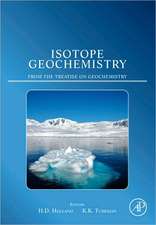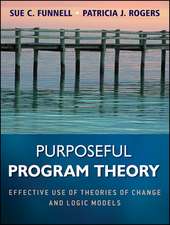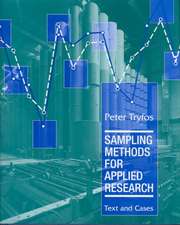The Uncertainty in Physical Measurements: An Introduction to Data Analysis in the Physics Laboratory
Autor Paolo Fornasinien Limba Engleză Hardback – 5 oct 2008
| Toate formatele și edițiile | Preț | Express |
|---|---|---|
| Paperback (1) | 944.82 lei 6-8 săpt. | |
| Springer – 28 oct 2010 | 944.82 lei 6-8 săpt. | |
| Hardback (1) | 948.92 lei 6-8 săpt. | |
| Springer – 5 oct 2008 | 948.92 lei 6-8 săpt. |
Preț: 948.92 lei
Preț vechi: 1157.22 lei
-18% Nou
Puncte Express: 1423
Preț estimativ în valută:
181.60€ • 185.97$ • 151.06£
181.60€ • 185.97$ • 151.06£
Carte tipărită la comandă
Livrare economică 19 martie-02 aprilie
Preluare comenzi: 021 569.72.76
Specificații
ISBN-13: 9780387786490
ISBN-10: 038778649X
Pagini: 289
Ilustrații: XII, 289 p.
Dimensiuni: 155 x 235 x 18 mm
Greutate: 0.54 kg
Ediția:2008
Editura: Springer
Colecția Springer
Locul publicării:New York, NY, United States
ISBN-10: 038778649X
Pagini: 289
Ilustrații: XII, 289 p.
Dimensiuni: 155 x 235 x 18 mm
Greutate: 0.54 kg
Ediția:2008
Editura: Springer
Colecția Springer
Locul publicării:New York, NY, United States
Public țintă
ResearchCuprins
Measurements and Uncertainty.- Physical Quantities.- Measurement Units.- Measuring Instruments.- Uncertainty in Direct Measurements.- Probability and Statistics.- Basic Probability Concepts.- Distributions of Random Variables.- Statistical Tools.- Data Analysis.- Uncertainty in Indirect Measurements.- Confidence Levels.- Correlation of Physical Quantities.- The Chi Square Test.- Appendices.- Presentation of Experimental Data.- Systems of Units.- Tables.- Mathematical Complements.- Experiments.
Recenzii
From the reviews:
"Aiming to fill the gap between tutorial-type resources and specialized treatises, this volume, which has been tested by Fornasini’s students in laboratory courses, offers a very clear, concise didactic approach to evaluating uncertainty. Actual worked examples are noted throughout the text, along with numerous figures depicting representative problems. Fornasini … addresses issues of uncertainty concerning significant digits and rounding, use of instruments, a posteriori evaluations, moments of several probability distributions, and indirect measurements. … Summing Up: Highly recommended. Upper-division undergraduates, researchers, and faculty." (D. J. Gougeon, Choice, Vol. 46 (10), June, 2009)
"The aim of this book … is to describe the nature of uncertainty in physical experiments and to provide the useful statistical tools for data analysis. … The present material is mainly addressed to the undergraduate students but could be applied by the researchers … and by the secondary school teachers as well. … we recommend this useful book for wide audience of readers without advanced knowledge of modern Mathematics." (Alexander V. Bulinski, Zentralblatt MATH, Vol. 1163, 2009)
“This is a book that arose from the author’s ‘long-lasting teaching experience’ in the Department of Physics of the University of Trento … . the author found a gap between the elementary texts used … and the more sophisticated books written for those with an extensive background in higher mathematics. This book attempts to fill that gap. … helpful to many students and indeed researchers. … many of us involved in radiation dosimetry would find much of help in this volume in our day-to-day work.” (Ralph H. Thomas, Radiation Protection Dosimetry, Vol. 140 (1), 2010)
"Aiming to fill the gap between tutorial-type resources and specialized treatises, this volume, which has been tested by Fornasini’s students in laboratory courses, offers a very clear, concise didactic approach to evaluating uncertainty. Actual worked examples are noted throughout the text, along with numerous figures depicting representative problems. Fornasini … addresses issues of uncertainty concerning significant digits and rounding, use of instruments, a posteriori evaluations, moments of several probability distributions, and indirect measurements. … Summing Up: Highly recommended. Upper-division undergraduates, researchers, and faculty." (D. J. Gougeon, Choice, Vol. 46 (10), June, 2009)
"The aim of this book … is to describe the nature of uncertainty in physical experiments and to provide the useful statistical tools for data analysis. … The present material is mainly addressed to the undergraduate students but could be applied by the researchers … and by the secondary school teachers as well. … we recommend this useful book for wide audience of readers without advanced knowledge of modern Mathematics." (Alexander V. Bulinski, Zentralblatt MATH, Vol. 1163, 2009)
“This is a book that arose from the author’s ‘long-lasting teaching experience’ in the Department of Physics of the University of Trento … . the author found a gap between the elementary texts used … and the more sophisticated books written for those with an extensive background in higher mathematics. This book attempts to fill that gap. … helpful to many students and indeed researchers. … many of us involved in radiation dosimetry would find much of help in this volume in our day-to-day work.” (Ralph H. Thomas, Radiation Protection Dosimetry, Vol. 140 (1), 2010)
Notă biografică
Since 1978, the author has worked on x-ray spectroscopy (XAFS) with Synchrotron Radiation. He participated in the realization of the PWA laboratories at Adone (Frascati) and of the italian beamline BM08-Gilda at ESRF (Grenoble). He regularly performs XAFS measurements at international synchrotron facilities, including Adone (Frascati), LURE (Orsay), ESRF (Grenoble). Prof. Fornasini has also developed a software package for the analysis of EXAFS, specifically tailored for the study of anharmonic thermal effects.
Prof. Fornasini has been a member of the International Advisory Committee on Synchrotron Radiation in Materials Science since 1996 and given several invited lectures and seminars in Chester (UK), Bonn, Regensburg, Bad Honnef, Dakar, Warsaw, Frascati, Bologna, Corvallis (Oregon), Stanford University, Hirosaki (Japan), Chiba (Japan). Since 1997, he is a lecturer at the Italian School of Synchrotron Radiation, organized every two years by the "Società Italiana di Luce di Sincrotrone". He has given lectures on x-ray techniques in various Italian and international schools (Torino 1999, Rostock 2000, Varsaw 2004, Planneralm Austria 2005, Dakar 2005).
Prof. Fornasini is the author or co-author of over 100 papers published in international journals and referees of the journals: Physical Review Letters, Physical Review B, Physics Letters, and Journal of Synchrotron Radiation.
Prof. Fornasini has been a member of the International Advisory Committee on Synchrotron Radiation in Materials Science since 1996 and given several invited lectures and seminars in Chester (UK), Bonn, Regensburg, Bad Honnef, Dakar, Warsaw, Frascati, Bologna, Corvallis (Oregon), Stanford University, Hirosaki (Japan), Chiba (Japan). Since 1997, he is a lecturer at the Italian School of Synchrotron Radiation, organized every two years by the "Società Italiana di Luce di Sincrotrone". He has given lectures on x-ray techniques in various Italian and international schools (Torino 1999, Rostock 2000, Varsaw 2004, Planneralm Austria 2005, Dakar 2005).
Prof. Fornasini is the author or co-author of over 100 papers published in international journals and referees of the journals: Physical Review Letters, Physical Review B, Physics Letters, and Journal of Synchrotron Radiation.
Textul de pe ultima copertă
All measurements of physical quantities are affected by uncertainty. Understanding the origin of uncertainty, evaluating its extent and suitably taking it into account in data analysis is essential for assessing the degree of accuracy of phenomenological relationships and physical laws in both scientific research and technological applications.
The Uncertainty in Physical Measurements: An Introduction to Data Analysis in the Physics Laboratory presents an introduction to uncertainty and to some of the most common procedures of data analysis. This book will serve the reader well by filling the gap between tutorial textbooks and highly specialized monographs. The book is divided into three parts. The first part is a phenomenological introduction to measurement and uncertainty: properties of instruments, different causes and corresponding expressions of uncertainty, histograms and distributions, and unified expression of uncertainty. The second part contains an introduction to probability theory, random variable distributions and basic statistical tools. The third part introduces the readers to some basic data analysis procedures: propagation of uncertainty, least squares fit, chi square test, and confidence intervals to name a few.
The introduction of probability and statistical tools is made on phenomenological grounds, as a natural response to the problems arising in the laboratory practice. The author has made a concentrated effort to guarantee both accuracy and clarity through the introduction of a large number of figures and worked examples, many of them taken from laboratory experimentations and practice. The book is enriched by the detailed proposal of several simple experiments.
Paolo Fornasini is a Professor of Physics at the University of Trento, Italy. He is the author, with Giuseppe Dalba, of Esercizi di Fisica: Meccanica e Termodinamica (Springer 2006).<
The Uncertainty in Physical Measurements: An Introduction to Data Analysis in the Physics Laboratory presents an introduction to uncertainty and to some of the most common procedures of data analysis. This book will serve the reader well by filling the gap between tutorial textbooks and highly specialized monographs. The book is divided into three parts. The first part is a phenomenological introduction to measurement and uncertainty: properties of instruments, different causes and corresponding expressions of uncertainty, histograms and distributions, and unified expression of uncertainty. The second part contains an introduction to probability theory, random variable distributions and basic statistical tools. The third part introduces the readers to some basic data analysis procedures: propagation of uncertainty, least squares fit, chi square test, and confidence intervals to name a few.
The introduction of probability and statistical tools is made on phenomenological grounds, as a natural response to the problems arising in the laboratory practice. The author has made a concentrated effort to guarantee both accuracy and clarity through the introduction of a large number of figures and worked examples, many of them taken from laboratory experimentations and practice. The book is enriched by the detailed proposal of several simple experiments.
Paolo Fornasini is a Professor of Physics at the University of Trento, Italy. He is the author, with Giuseppe Dalba, of Esercizi di Fisica: Meccanica e Termodinamica (Springer 2006).<
Caracteristici
Contains an up-to-date introduction to uncertainty in measurements, based on a comprehensive analysis of its possible different clauses Contains mathematical topics, important for many laboratory courses, which are not thoroughly discussed in competing works The figures and worked examples included in the text are taken from real laboratory practice and will highlight strengths and limitations of statistical methods Contains worked-out problems and an appendix with descriptions of experiments so students can easily obtain realistic data on which to apply theoretical recipes Includes supplementary material: sn.pub/extras











